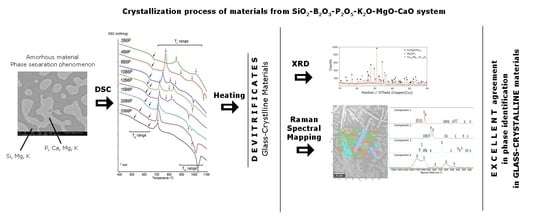Investigating the Crystallization Process of Boron-Bearing Silicate-Phosphate Glasses by Thermal and Spectroscopic Methods
Abstract
1. Introduction
2. Materials and Methods
2.1. Synthesis of SiO2–B2O3–P2O5–K2O–CaO–MgO Glasses
2.2. Characterization
3. Results and Discussion
3.1. Characteristics of the Analyzed Glasses
3.2. Glass Stability vs. Phase Separation Phenomenon
3.3. Crystallization Process
3.3.1. X-ray Diffraction Analysis in the Study of Crystallization Products
3.3.2. Spectroscopic Methods in the Study of Crystallization Products
3.4. Chemical Affinity as a Factor Determining the Type of Crystallizing Phase
4. Conclusions
Author Contributions
Funding
Institutional Review Board Statement
Informed Consent Statement
Data Availability Statement
Acknowledgments
Conflicts of Interest
Sample Availability
References
- Duke, D.A. Glass: Theory of crystallization. In Mineralogy. Encyclopedia of Earth Science; Springer: Boston, MA, USA, 1981. [Google Scholar] [CrossRef]
- Richardson, M.J. The Glass Transition Region. In Calorimetry and Thermal Analysis of Polymers; Method, V.B.F., Ed.; Hanser Publishers: Liberty Township, OH, USA, 1994; pp. 169–188. [Google Scholar]
- Lebedeva, G.A. Formation of a Liquation structure in titanium-containing aluminosilicate glass. Glass Ceram. 2008, 65, 316–318. [Google Scholar] [CrossRef]
- Uvarov, E.B. Catalyzed Crystallization of Glass. In The Structure of Glass; book series (SOG); Springer: Boston, MA, USA, 1964; Volume 3. [Google Scholar] [CrossRef]
- Stoch, L. Thermochemistry of Solids with Flexible Structures. J. Therm. Anal. 1998, 54, 9–24. [Google Scholar] [CrossRef]
- Stoch, L. Thermal analysis and thermochemistry of vitreous into crystalline state transition. J. Therm. Anal. Cal. 2004, 77, 7–16. [Google Scholar] [CrossRef]
- Lopes, A.A.S.; Soares, R.S.; Lima, M.M.A.; Monteiro, R.C.C. Glass transition and crystallization kinetics of a barium borosilicate glass by a non-isothermal method. J. App. Phys. 2014, 115, 043516. [Google Scholar] [CrossRef]
- Saisuk, Y.; Ayawanna, J.; Laorodphan, N. Crystallisation of BaO-ZnO-SiO2-B2O3 Glasses: Effect of ZnO content, nucleation temperature and time. In Proceedings of the 34th MST Annual Conference, Bangkok, Thailand, 31 May–2 June 2017. [Google Scholar] [CrossRef]
- Kržmanc, M.M.; Došler, U.; Suvorov, D. The nucleation and crystallization of MgO–B2O3–SiO2 glass. J. Eur. Ceram. Soc. 2011, 31, 2211–2219. [Google Scholar] [CrossRef]
- Zhua, H.; Fu, R.; Agathopoulos, S.; Fang, J.; Li, G.; He, Q. Crystallization behaviour and properties of BaO-CaO-B2O3-SiO2 glasses and glass-ceramics for LTCC applications. Ceram. Int. 2018, 44, 10147–10153. [Google Scholar] [CrossRef]
- Mošner, P.; Vosejpková, K.; Koudelka, L.; Benes, L. Thermal studies of ZnO–B2O3–P2O5–TeO2 glasses. J. Therm. Anal. Calorim. 2012, 107, 1129–1135. [Google Scholar] [CrossRef]
- Liu, S.; Yang, R.; Wang, Y. Effects of the substitution of P2O5 with B2O3 on the structure, iron valence, thermal and crystallization behavior of lithium-iron-phosphate glasses. J. Non-Cryst. Solids 2016, 453, 158–193. [Google Scholar] [CrossRef]
- Kalenda, P.; Koudelka, L.; Mošner, P.; Benes, L. Thermal behavior and the properties of BaO–B2O3–P2O5 glasses. J. Therm. Anal. Calorim. 2016, 124, 1161–1168. [Google Scholar] [CrossRef]
- Hu, Y.; Tsai, H.-T. The effect of BaO on the crystallization behaviour of a cordierite-type glass. Mat. Chem. Phys. 1998, 52, 184–188. [Google Scholar] [CrossRef]
- Xie, K.; Zhang, L.; Yang, X.; Wang, X.; Yang, G.; Zhang, L.; Shao, H.; He, Y.; Fu, J.; Gou, Z. Preparation and Characterization of Low Temperature Heat-Treated 45S5 Bioactive Glass-Ceramic Analogues. Biomed. Glasses 2015, 1, 80–92. [Google Scholar] [CrossRef]
- Fabert, M.; Ojha, N.; Erasmus, E.; Hannula, M.; Hokka, M.; Hyttinen, J.; Rocherulle’, J.; Sigalascd, I.; Massera, J. Crystallization and sintering of borosilicate bioactive glasses for application in tissue engineering. J. Mater. Chem. B 2017, 5, 4514–4525. [Google Scholar] [CrossRef] [PubMed]
- Wacławska, I.; Szumera, M. Reactivity of silicate-phosphate glasses in soil environment. J. Alloy. Comp. 2009, 468, 246–253. [Google Scholar] [CrossRef]
- Szumera, M.; Wacławska, I.; Olejniczak, Z. Influence of B2O3 on the structure and crystallization of soil active glasses. J. Therm. Anal. Cal. 2010, 99, 879–886. [Google Scholar] [CrossRef]
- Łagowska, B.; Wacławska, I.; Sitarz, M.; Szumera, M. Spectroscopic studies of structural interactions in silicate-boratephosphate glass. J. Mol. Struct. 2018, 1171, 110–116. [Google Scholar] [CrossRef]
- Kozmidis-Petrovic, A.F. Theoretical analysis of relative changes of the Hruby, Weinberg, and Lu–Liu glass stability parameters with application on some oxide and chalcogenide glasses. Thermochim. Acta 2010, 499, 54–60. [Google Scholar] [CrossRef]
- Hrubỷ, A. Evaluation of glass-forming tendency by means of DTA. Czech. J. Phys. B 1972, 22, 1187–1193. [Google Scholar] [CrossRef]
- Weinberg, M.C. An assessment of glass stability criteria. Phys. Chem. Glasses 1994, 35, 119–123. [Google Scholar]
- Lu, Z.P.; Liu, C.T. Glass Formation Criterion for Various Glass-Forming Systems. Phys. Rev. Lett. 2003, 91, 115505-1–115505-4. [Google Scholar] [CrossRef]
- Łagowska, B.; Wacławska, I.; Sułowska, J.; Olejniczak, Z.; Sulikowski, B.; Szumera, M. Glass transition effect in liquation silicate–borate–phosphate glasses. J. Therm. Anal. Calorim. 2019, 138, 2251–2262. [Google Scholar] [CrossRef]
- Vogel, W. Crystallization of Glasses. In Glass Chemistry; Vogel, W., Ed.; Springer: Berlin/Heidelberg, Germany, 1994; pp. 280–362. [Google Scholar] [CrossRef]
- Brown, W.E.; Dickens, B. Tschermaks Mineralogische und Petrographische Mitteilungen, by Geologische Bundesanstalt (Austria). Jahrbuch. Supplement. SpringerLink (Online service). 1882, pp. 79–104. Available online: https://hdl.handle.net/2027/nyp.33433069063000 (accessed on 22 December 2021).
- Frost, L.R.; Wills, R.A.; Martens, W.N. A Raman spectroscopic study of synthetic giniite. Spectrochim. Acta A 2007, 66, 42–47. [Google Scholar] [CrossRef] [PubMed][Green Version]
- Lehr, J.R.; Brown, E.H.; Frazier, A.W.; Smith, J.P.; Thrasher, D. Crystallographic Properties of Fertilizer Compounds; Tennessee Valley Authority, National Fertilizer Development Center: Knoxville, TN, USA, 1967; p. 6. Available online: https://books.google.pl/books?id=C9ikyAEACAAJ (accessed on 22 December 2021).
- Barin, I.; Knacke, O.; Kubaschewski, O. Thermochemical Properties of Inorganic Substances; Springer: Berlin/Heidelberg, Germany, 1973; ISBN ISBN 978-3-662-02293-1. [Google Scholar] [CrossRef]

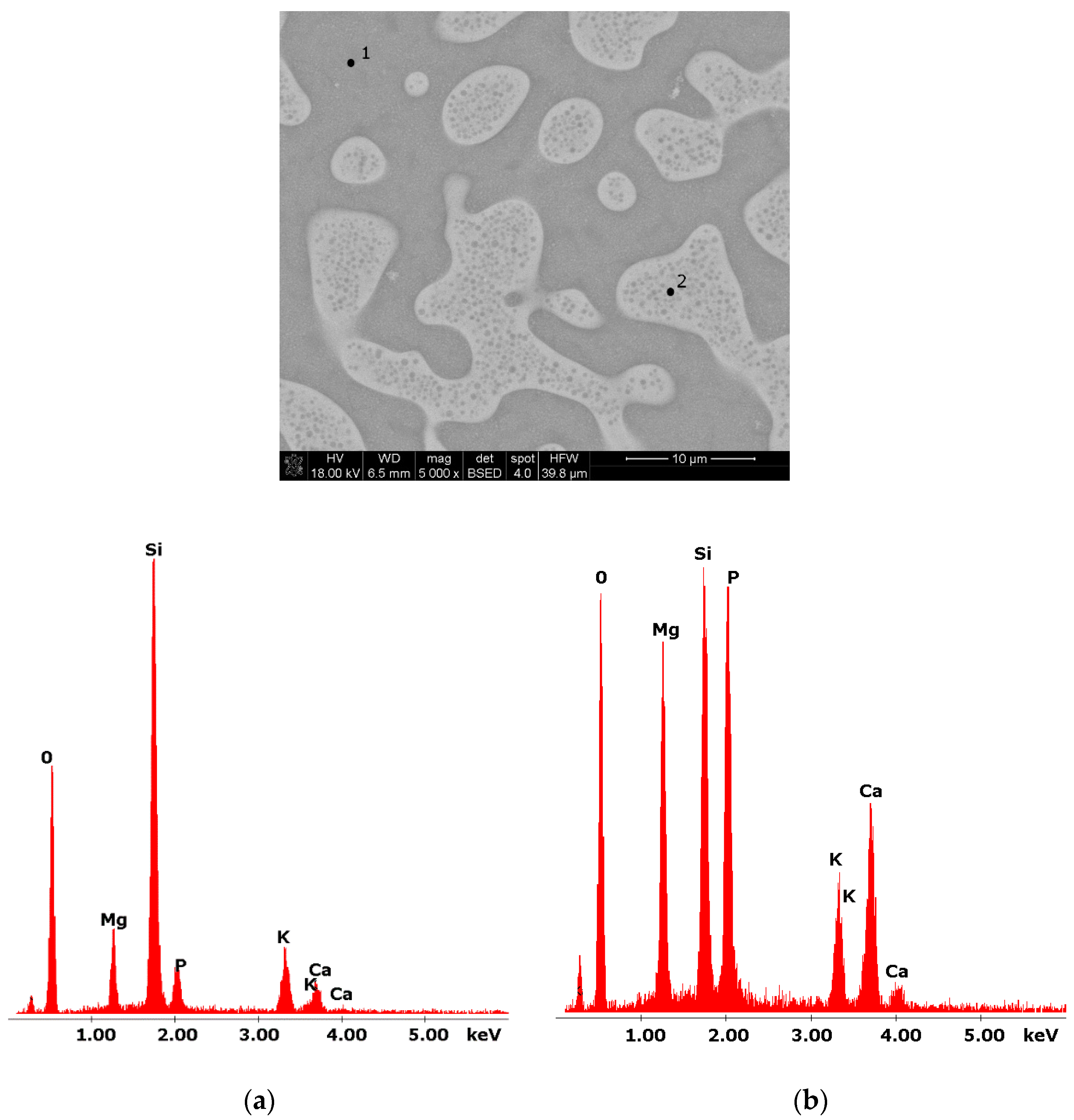
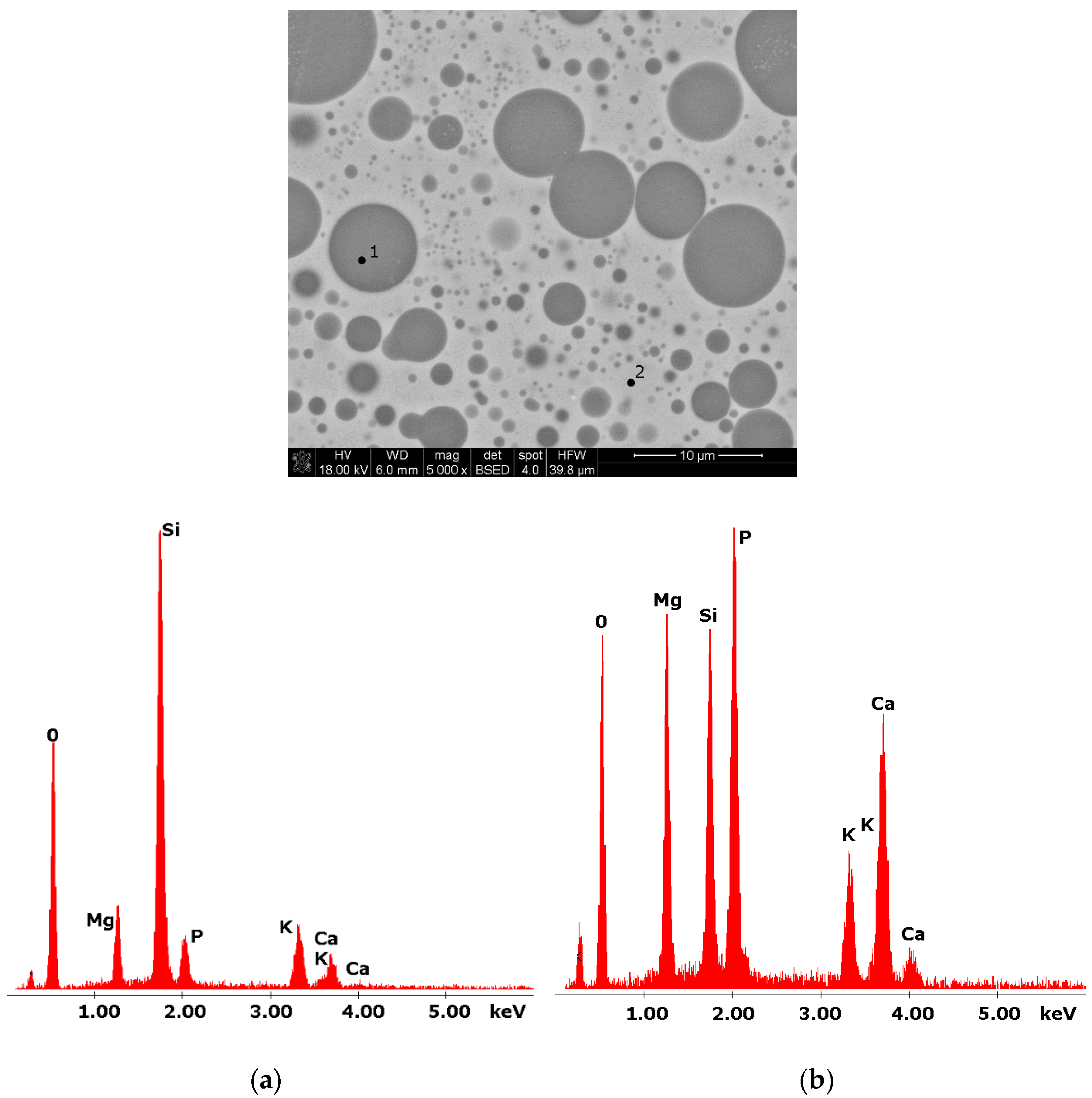
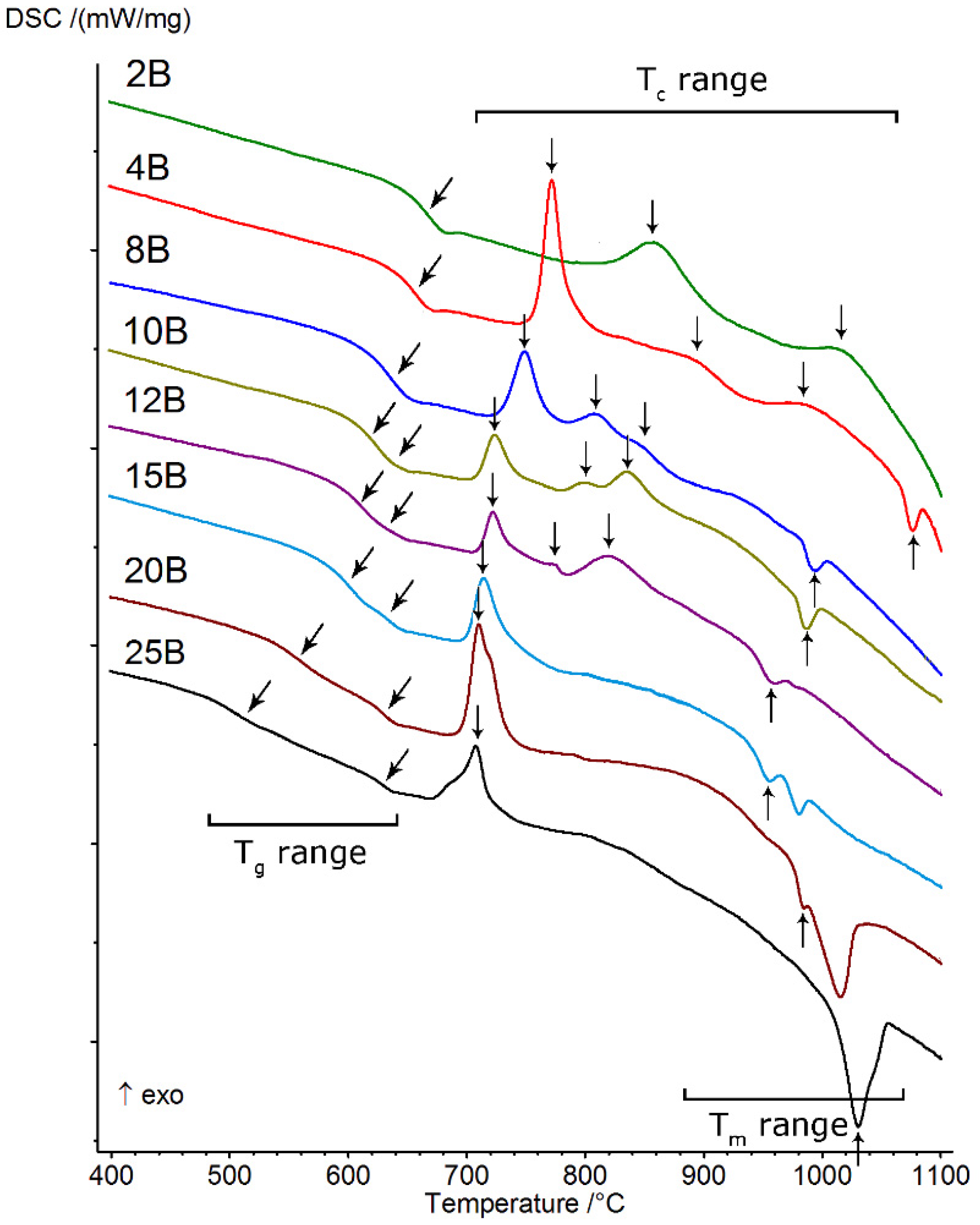
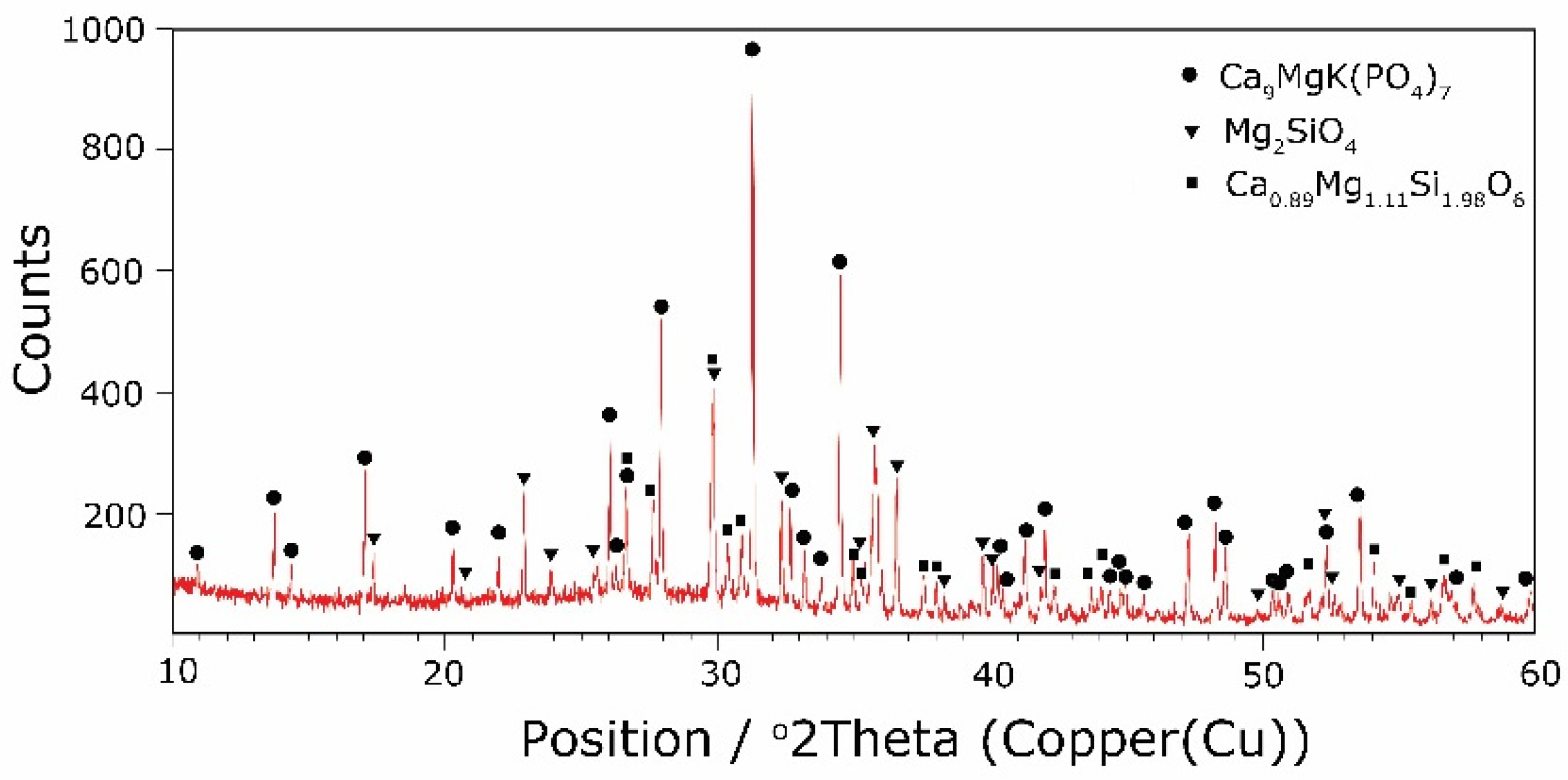
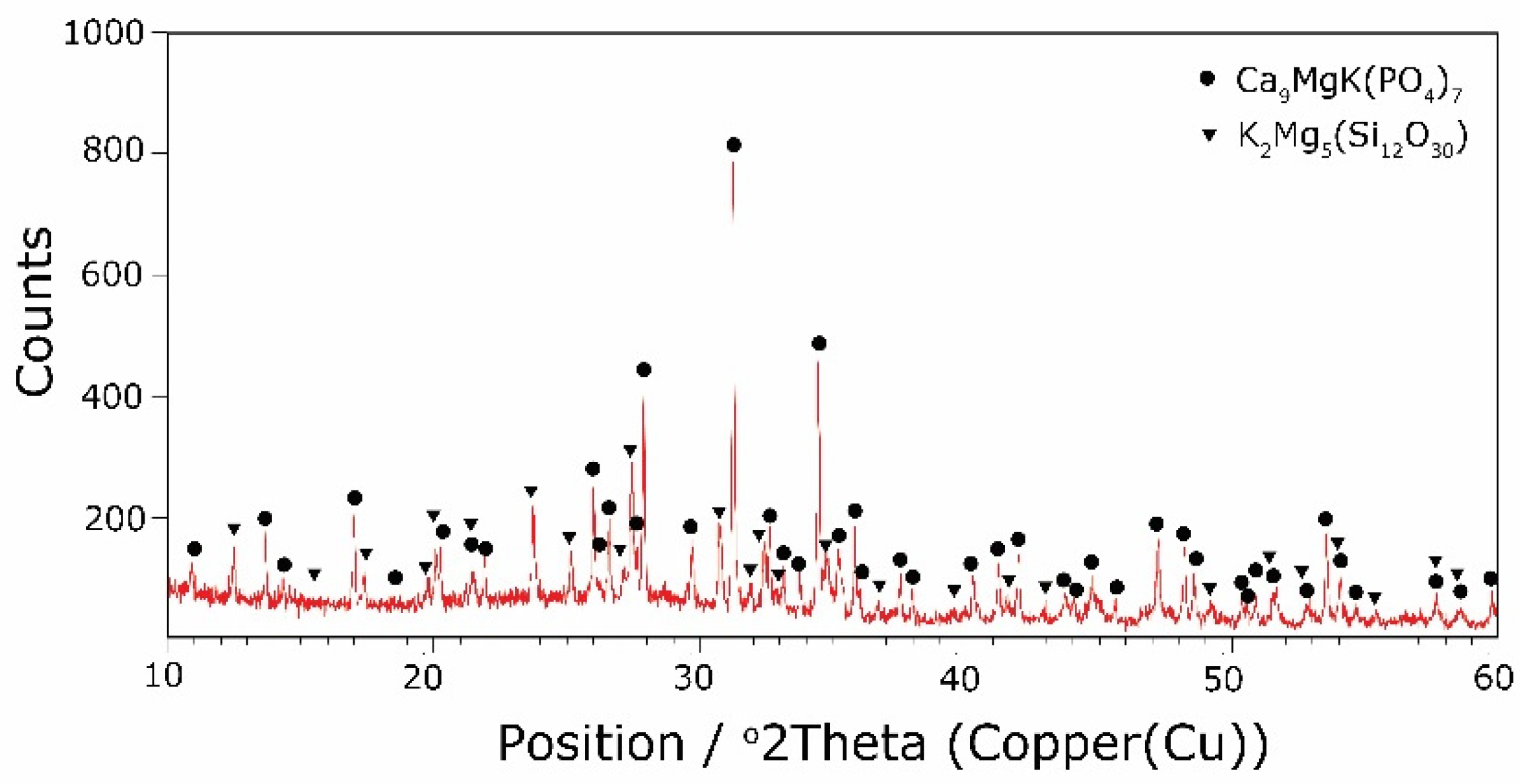
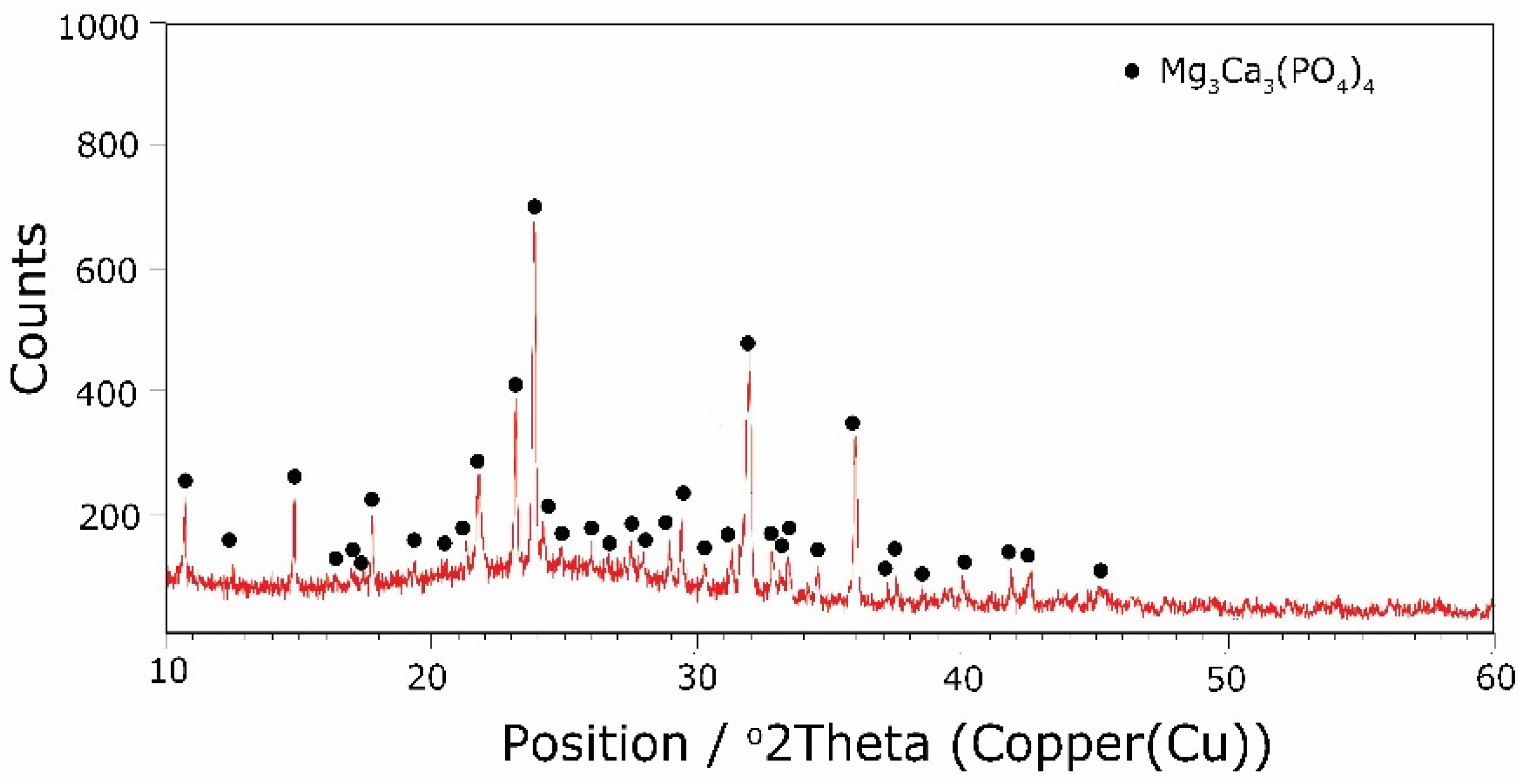

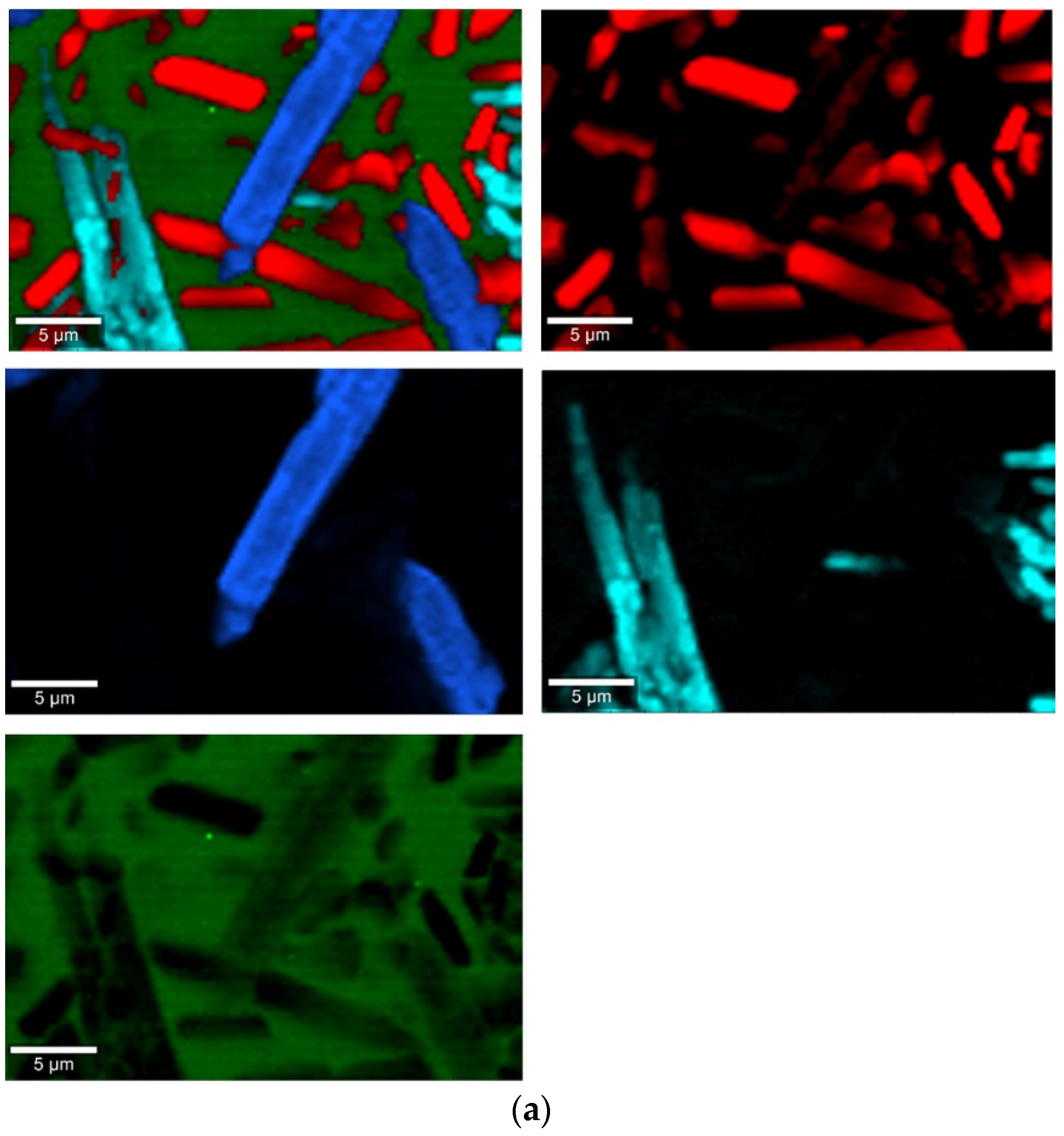
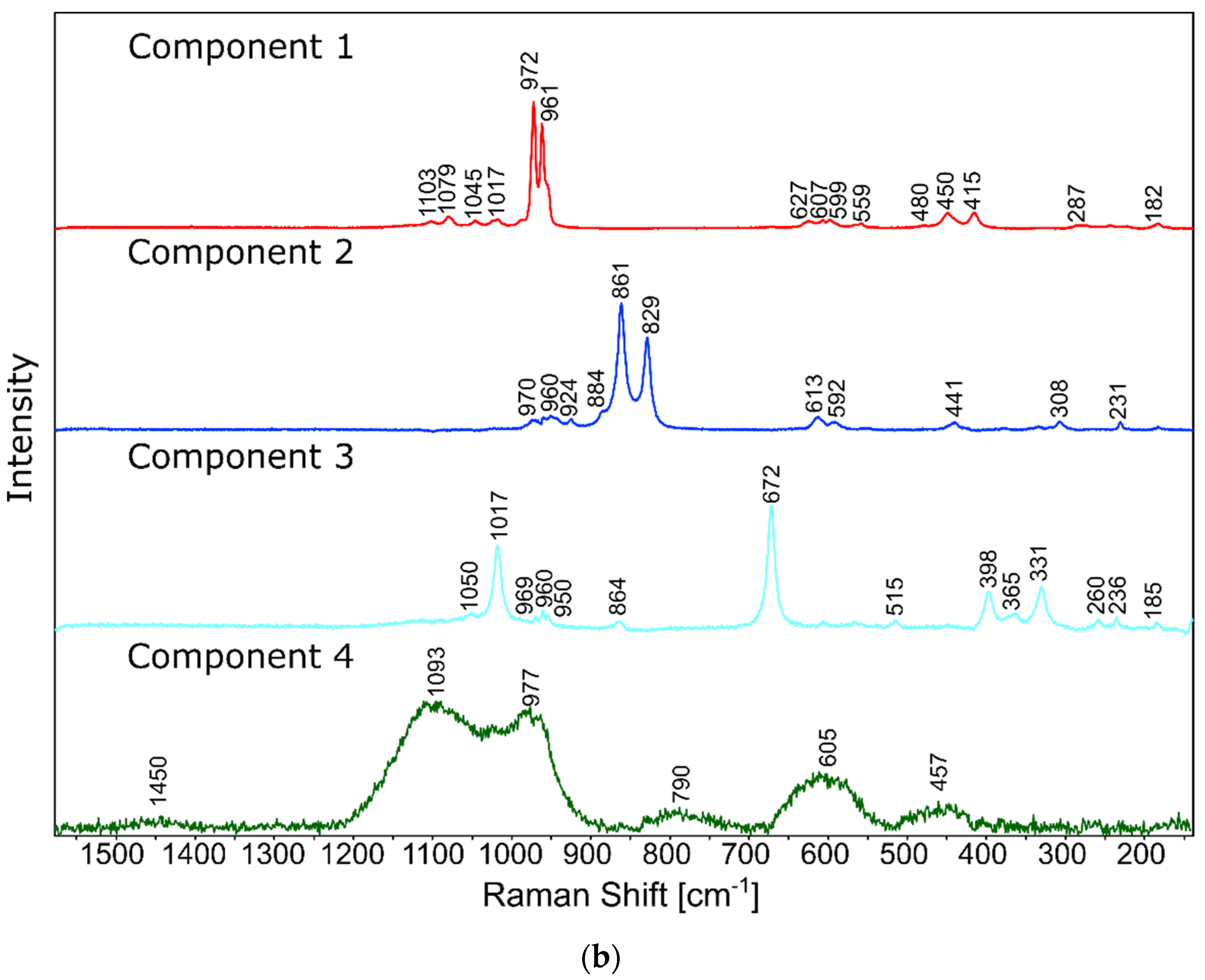
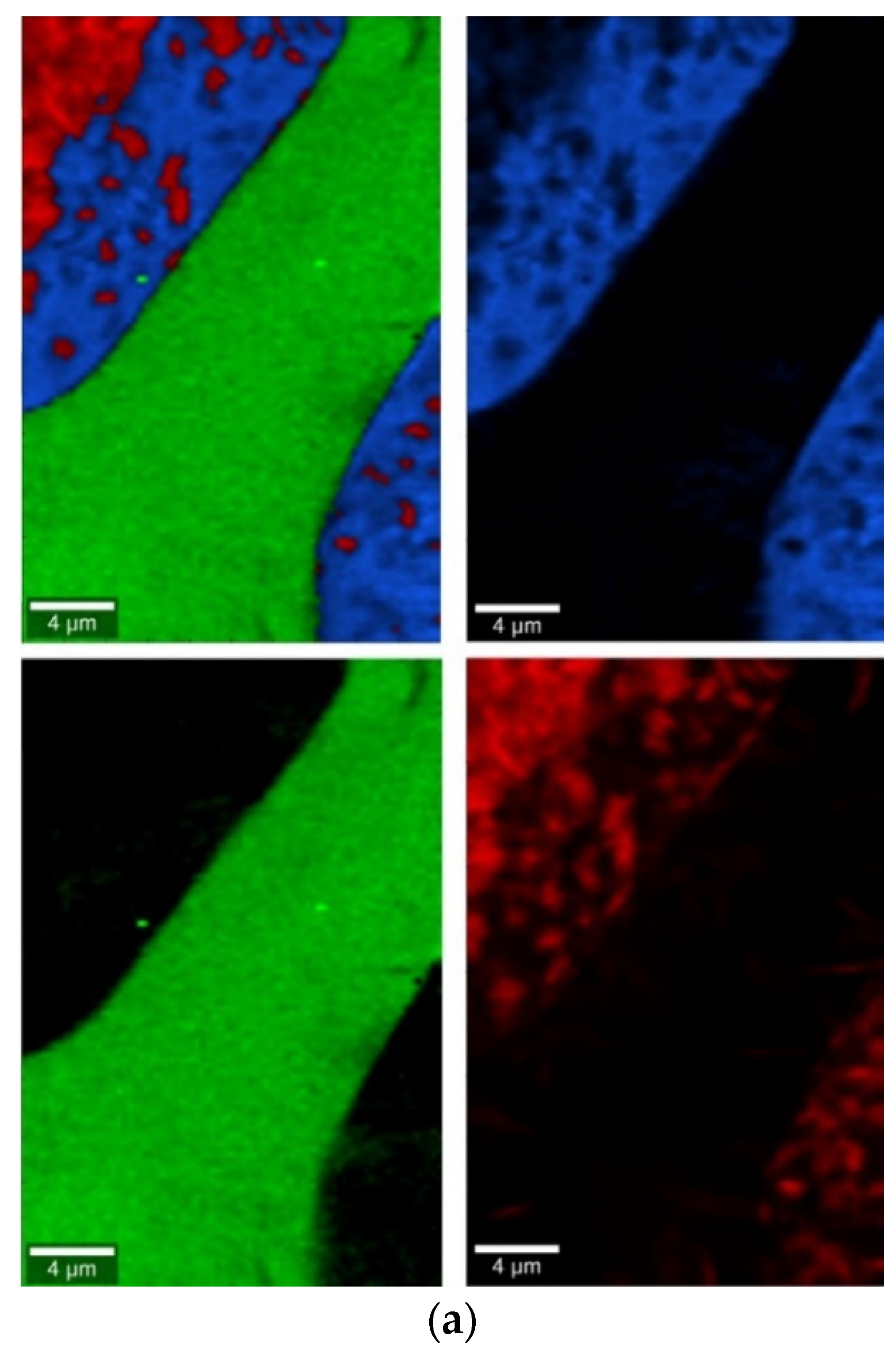


| Name of Sample | SiO2 | P2O5 | B2O3 | K2O | MgO | CaO | |
|---|---|---|---|---|---|---|---|
| 2B | 41 | 6 | 2 | 6 | 27.0 | 18.0 | 0.042 |
| 4B | 41 | 6 | 4 | 6 | 25.8 | 17.2 | 0.085 |
| 8B | 41 | 6 | 8 | 6 | 23.4 | 15.6 | 0.170 |
| 10B | 41 | 6 | 10 | 6 | 22.2 | 14.8 | 0.212 |
| 12B | 41 | 6 | 12 | 6 | 21.0 | 14.0 | 0.255 |
| 14B | 41 | 6 | 14 | 6 | 19.8 | 13.2 | 0.297 |
| 15B | 41 | 6 | 15 | 6 | 19.2 | 12.8 | 0.319 |
| 20B | 41 | 6 | 20 | 6 | 16.2 | 10.8 | 0.425 |
| 25B | 41 | 6 | 25 | 6 | 13.2 | 8.8 | 0.531 |
| Glass Transition Range | Crystallization Range | Melting Range | The Glass Stability Parameters (GS) | ||||||||||
|---|---|---|---|---|---|---|---|---|---|---|---|---|---|
| Maximum Crystallization Peaks | Onset of Crystallization Peaks | ||||||||||||
| Sample | Tg/°C | Tc1/°C | Tc2/°C | Tc3/°C | Tx1/°C | Tx2/°C | Tx3/°C | Tm/°C | ΔT/°C | KW | KH | Krg | |
| 0B6P [24] | 679 | 844 | 896 | 836 | n.o. | 157 | n.o. | n.o. | n.o. | ||||
| 2B | 660 | 858 | 1007 | 814 | 975 | n.o. | 154 | n.o. | n.o. | n.o. | |||
| 4B | 651 | 772 | 886 | 988 | 756 | 858 | 952 | 1068 | 105 | 0.113 | 0.337 | 0.610 | |
| 8B | 631 | 749 | 808 | 847 | 726 | 785 | 829 | 983 | 95 | 0.120 | 0.370 | 0.642 | |
| 10B | 1st Tg | 626 | 724 | 708 | 988 | 82 | 0.099 | 0.293 | 0.634 | ||||
| 2nd Tg | 648 | 724 | 798 | 835 | 708 | 785 | 818 | 988 | 60 | 0.077 | 0.214 | 0.656 | |
| 12B8 | 1st Tg | 614 | 722 | 708 | 958 | 94 | 0.113 | 0.376 | 0.641 | ||||
| 2nd Tg | 642 | 722 | 775 | 819 | 708 | n.o. | 787 | 958 | 66 | 0.084 | 0.264 | 0.670 | |
| 15B | 1st Tg | 606 | 714 | 699 | 956 | 93 | 0.113 | 0.362 | 0.634 | ||||
| 2nd Tg | 634 | 714 | 699 | 956 | 65 | 0.084 | 0.253 | 0.663 | |||||
| 20B | 1st Tg | 556 | 710 | 696 | 984 | 140 | 0.157 | 0.486 | 0.565 | ||||
| 2nd Tg | 629 | 710 | 720 * | 696 | 984 | 67 | 0.082 | 0.233 | 0.639 | ||||
| 25B | 1st Tg | 502 | 708 | 672 | 1031 | 170 | 0.200 | 0.474 | 0.487 | ||||
| 2nd Tg | 628 | 708 | 683 * | 672 | 1031 | 44 | 0.078 | 0.123 | 0.609 | ||||
| No. | Crystallization Temperature (Tc) (°C) | Crystalline Phases | Reference Code | Fraction (%) | Rwp | Pp | χ2 |
|---|---|---|---|---|---|---|---|
| 0B6P [18] | 844 | Ca9MgK(PO4)7 | n.o. | ||||
| 896 | Ca9MgK(PO4)7 | n.o. | |||||
| 2B | 858 | Ca9MgK(PO4)7 | 98-008-5109 | 77.9 | 13.66 | 11.08 | 1.263 |
| K2Mg5(Si12O30) | 98-007-7131 | 21.1 | |||||
| 1007 | Ca9MgK(PO4)7 | 98-008-5109 | 80.5 | 10.79 | 9.4 | 0.854 | |
| Mg2SiO4 | 98-020-2370 | 17.1 | |||||
| CaMgSi2O6 | 98-001-0224 | 2.4 | |||||
| 4B | 772 | Ca9MgK(PO4)7 | 98-008-5109 | 100 | 9.4 | 7.74 | 1.29 |
| 886 | Ca9MgK(PO4)7 | 98-008-5109 | 79.9 | 12.94 | 10.17 | 1.223 | |
| K2Mg5(Si12O30) | 98-007-7131 | 12.2 | |||||
| Ca9.5+0.5x((PO4)6-x(BO3))(BO2)1-xOx) | 98-006-8336 | 7.9 | |||||
| 988 | Ca9MgK(PO4)7 | 98-008-5109 | 79.9 | 10.49 | 8.84 | 0.72 | |
| MgSiO3 | 98-003-0893 | 15.8 | |||||
| CaMg(Si2O6) | 98-008-9856 | 3 | |||||
| K(BSi2O6) | 98-026-1715 | 1.3 | |||||
| 8B | 749 | Ca9MgK(PO4)7 | 98-008-5109 | 100 | 10.73 | 9.39 | 0.629 |
| 808 | Ca9MgK(PO4)7 | 98-008-5109 | 85 | 10.8 | 9.15 | 0.681 | |
| K2Mg5(Si12O30) | 98-007-7131 | 15 | |||||
| 847 | Ca9MgK(PO4)7 | 98-008-5109 | 81.8 | 10.1 | 8.4 | 0.747 | |
| K2Mg5(Si12O30) | 98-007-7131 | 7.5 | |||||
| Ca9.5+0.5x((PO4)6-x(BO3))(BO2)1-xOx) | 98-006-8336 | 8.4 | |||||
| K(BSi2O6) | 98-026-1715 | 2.3 | |||||
| 10B | 724 | Ca9MgK(PO4)7 | 98-008-5109 | 75.2 | 10.98 | 9.48 | 0.634 |
| Mg3Ca3(PO4)4 | 98-002-3642 | 24.8 | |||||
| 798 | Ca9MgK(PO4)7 | 98-008-5109 | 84 | 10.77 | 9.12 | 0.606 | |
| K2Mg5(Si12O30) | 98-007-7131 | 16 | |||||
| 835 | Ca9MgK(PO4)7 | 98-008-5109 | 81.9 | 10.91 | 8.96 | 0.718 | |
| K2Mg5(Si12O30) | 98-007-2717 | 7.9 | |||||
| Ca9.5+0.5x((PO4)6-x(BO3))(BO2)1-xOx) | 98-006-8336 | 6.3 | |||||
| K(Bsi2O6) | 98-026-1715 | 4 | |||||
| 12B | 722 | Ca9MgK(PO4)7 | 98-008-5109 | 80.6 | 10.64 | 9.31 | 0.581 |
| Mg3Ca3(PO4)4 | 98-002-3642 | 19.4 | |||||
| 819 | Ca9MgK(PO4)7 | 98-008-5109 | 45.1 | 11.87 | 10.22 | 0.807 | |
| Mg3Ca3(PO4)4 | 98-002-3642 | 41.9 | |||||
| K(Bsi3O8) | 98-006-9445 | 8.2 | |||||
| Ca9.5+0.5x((PO4)6-x(BO3))(BO2)1-xOx) | 98-006-8336 | 4.7 | |||||
| 15B | 714 | Ca9MgK(PO4)7 | 98-008-5109 | 37.9 | 11.19 | 9.59 | 0.643 |
| Mg3Ca3(PO4)4 | 98-002-3642 | 62.1 | |||||
| 20B | 710 | Ca9MgK(PO4)7 | 98-008-5109 | 8 | 14.04 | 11.9 | 0.931 |
| Mg3Ca3(PO4)4 | 98-002-3642 | 72 | |||||
| 25B | 708 | Mg3Ca3(PO4)4 | 98-002-3642 | 100 | 14.63 | 12.27 | 0.938 |
| Compounds | ΔG [kJ/mol] | |||
|---|---|---|---|---|
| 900 K | 1000 K | 1100 K | ||
| Ca9MgK(PO4)7 | 9CaO·MgO·0.5K2O·3.5P2O5 | –18,846.6 | –19,196.9 | –19,563.9 |
| K2Mg5(Si12O30) | K2O·5 MgO·12 SiO2 | –15,336.6 | –15,534.0 | –15,743.5 |
| Mg3Ca3(PO4)4 | 3MgO·3CaO·2P2O5 | –10,716.1 | –10,909.2 | –11,111.5 |
| CaMg(Si2O6) | CaO·MgO·2SiO2 | –3271.4 | –3311.9 | –3354.8 |
| Mg2SiO4 | 2MgO·SiO2 | –2255.3 | –2282.7 | –2311.8 |
| MgSiO3 | MgO·SiO2 | –1612.6 | –1632.0 | –1652.7 |
| Compounds | ΔG [kJ/mol] | |||
|---|---|---|---|---|
| 900 K | 1000 K | 1100 K | ||
| Ca9.93(P5.84B0.16O24)B0.67O1.79 | 9.93CaO·2.92 P2O5·0.415B2O3 | –17,217.4 | –17,526.0 | –17,849.5 |
| K(BSi2O6) | 0.5K2O·0.5B2O3·2SiO2 | –2861.4 | –2904.3 | –2949.9 |
| K(BSi3O8) | 0.5K2O·0.5B2O3·3SiO2 | –3831.3 | –3885.7 | –3943.3 |
Publisher’s Note: MDPI stays neutral with regard to jurisdictional claims in published maps and institutional affiliations. |
© 2022 by the authors. Licensee MDPI, Basel, Switzerland. This article is an open access article distributed under the terms and conditions of the Creative Commons Attribution (CC BY) license (https://creativecommons.org/licenses/by/4.0/).
Share and Cite
Szumera, M.; Łagowska, B.; Sułowska, J.; Jeleń, P.; Olejniczak, Z.; Lach, R.; Berezicka, A.; Kijo-Kleczkowska, A. Investigating the Crystallization Process of Boron-Bearing Silicate-Phosphate Glasses by Thermal and Spectroscopic Methods. Molecules 2022, 27, 867. https://doi.org/10.3390/molecules27030867
Szumera M, Łagowska B, Sułowska J, Jeleń P, Olejniczak Z, Lach R, Berezicka A, Kijo-Kleczkowska A. Investigating the Crystallization Process of Boron-Bearing Silicate-Phosphate Glasses by Thermal and Spectroscopic Methods. Molecules. 2022; 27(3):867. https://doi.org/10.3390/molecules27030867
Chicago/Turabian StyleSzumera, Magdalena, Barbara Łagowska, Justyna Sułowska, Piotr Jeleń, Zbigniew Olejniczak, Radosław Lach, Anna Berezicka, and Agnieszka Kijo-Kleczkowska. 2022. "Investigating the Crystallization Process of Boron-Bearing Silicate-Phosphate Glasses by Thermal and Spectroscopic Methods" Molecules 27, no. 3: 867. https://doi.org/10.3390/molecules27030867
APA StyleSzumera, M., Łagowska, B., Sułowska, J., Jeleń, P., Olejniczak, Z., Lach, R., Berezicka, A., & Kijo-Kleczkowska, A. (2022). Investigating the Crystallization Process of Boron-Bearing Silicate-Phosphate Glasses by Thermal and Spectroscopic Methods. Molecules, 27(3), 867. https://doi.org/10.3390/molecules27030867






